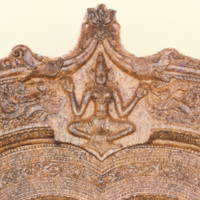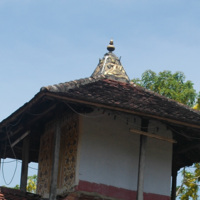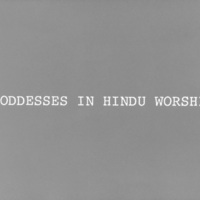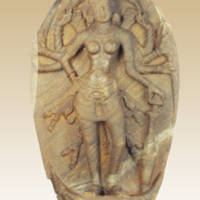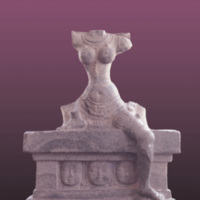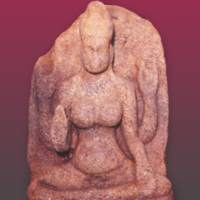Main Menu
AORC Libraries
Browse Items in Women in Sri Lankan Sculpture and Painting (166 total)
4-armed Gajalakshmi
Description: This slide was made from a picture from the Department of Archaeology. It shows a stone relief of the Gajalaksmi symbol, presently found in the Archaeological Museum, Jaffna, Sri Lanka. It was probably associated with a Hindu temple. It is noteworthy that this particular Laksmi is 4-armed whereas the usual Laksmi carving on Buddhist temples displays only 2 arms.
Contributor: Co-Author: Seneviratna, Harsha
Collection: Women in Sri Lankan Sculpture and Painting
Goddess Lakshmi
Description: Laksmi without the elephants occupies the central position of this very elaborate stone doorway, at the eastern entrance to the Potgul Vihare at Hanguranketa, Sri Lanka. The style and workmanship suggests that it was probably done by a South Indian artist at the court of the Nayakkar Kings of Kandy.
Contributor: Co-Author: Seneviratna, Harsha
Collection: Women in Sri Lankan Sculpture and Painting
Goddess Lakshmi without elephants
Description: The elevation of goddess Laksmi to the very pinnacle of the main shrine at the Ambakke Devale in the Kandy district, Sri lanka is extremely significant. That it was considered fitting to adorn 3 sides of the brass pinnacle raised above the sanctuary of the male god with a carving of the seated goddess in this 17th century devale, deserves attention.
Contributor: Co-Author: Seneviratna, Harsha
Collection: Women in Sri Lankan Sculpture and Painting
Goddesses in Hindu Worship
Description: Goddesses in Hindu Worship: The worship of goddesses is more widespread in Hinduism than in Buddhism. They fall into two broad categories, the goddess venerated as cult deity in her own right and the goddess as female companion of the male god.
Contributor: Co-Author: Seneviratna, Harsha
Collection: Women in Sri Lankan Sculpture and Painting
Tags: AISLS, Goddesses in Hindu Worship, ICES, PDWESLSP
Durgā taming a buffalo
Description: This stone image, an eight armed goddess, falls into the category of cult deity. Found near Mihintale, Sri Lanka and perhaps dating to the Cola period, it is presently in the Colombo National Museum. Standing on the head of a buffalo and bearing the traditional weapons associated with Durga, the image, is a representation of the goddess as Mahisasuramardini. Dated in the 11th century A.D.
Contributor: Co-Author: Seneviratna, Harsha
Collection: Women in Sri Lankan Sculpture and Painting
Tags: AISLS, Goddesses in Hindu Worship, ICES, PDWESLSP
Durgā destroying Ásura
Description: An aspect of Durga, the destroyer of Asura, is represented in this seated, headless stone image from the Colombo National Museum. It may be ascribed to the Cola period of Sri Lanka’s history. Dated in the 11th century A.D.
Contributor: Co-Author: Seneviratna, Harsha
Collection: Women in Sri Lankan Sculpture and Painting
Tags: AISLS, Goddesses in Hindu Worship, ICES, PDWESLSP
Cāmuṇḍāā, one of the Seven Mothers
Description: Among the group of goddesses known as Saptamatrka or Seven Mothers and belonging to the phase of Cola influence in Sri Lanka’s history, is this stone image of Camunda. Eight armed, she has close affiliations to Durga and even to the Buddhist Goddess Tara. Found among the ruins of a devalaya at Mahakandarava near Mihintale, Sri Lanka, the image is now houses at the Archaeological Museum in Anuradhapura, Sri Lanka. Dated in the 11th century A.D.
Contributor: Co-Author: Seneviratna, Harsha
Collection: Women in Sri Lankan Sculpture and Painting
Tags: AISLS, Goddesses in Hindu Worship, ICES, PDWESLSP
Brahmi, consort of Brahma, one of the Seven Mothers
Description: This stone image of 4-armed Brahmi, the female concert of Brahma, recognizable because of her 3 faces, is seen at the Archaeological Museum in Anuradhapura, Sri Lanka. Dated in the 11th century A.D.
Contributor: Co-Author: Seneviratna, Harsha
Collection: Women in Sri Lankan Sculpture and Painting
Tags: AISLS, Goddesses in Hindu Worship, ICES, PDWESLSP
Varahi, one of the Seven Mothers
Description: Varahi, the boar-faced goddess among the Saptamatrkas. She too is 4-armed and like the rest sits in ardhaparyanka or in a half cross-legged posture. This goddess is seen at the Archaeological Museum in Anuradhapura, Sri Lanka. Dated in the 11th century A.D.
Contributor: Co-Author: Seneviratna, Harsha
Collection: Women in Sri Lankan Sculpture and Painting
Tags: AISLS, Goddesses in Hindu Worship, ICES, PDWESLSP
4-armed Hindu goddess, one of the Seven Mothers
Description: A goddess among the Saptamatrka, also from Mahakandarava, Sri Lanka, this stone image is presently housed in the Archaeological Museum at Mihintale, Sri Lanka. Dated in the 11th century A.D.
Contributor: Co-Author: Seneviratna, Harsha
Collection: Women in Sri Lankan Sculpture and Painting
Tags: AISLS, Goddesses in Hindu Worship, ICES, PDWESLSP




